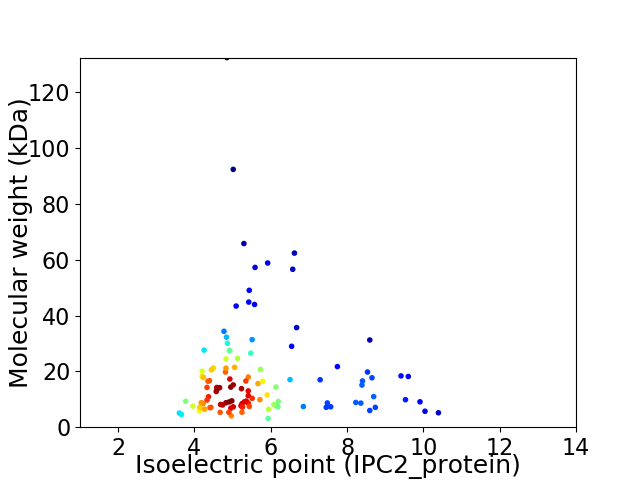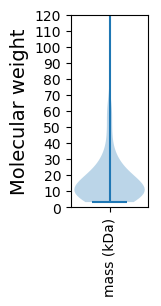
Microbacterium phage Hubbs
Taxonomy: Viruses; Duplodnaviria; Heunggongvirae; Uroviricota; Caudoviricetes; Caudovirales; Siphoviridae; unclassified Siphoviridae
Average proteome isoelectric point is 5.75
Get precalculated fractions of proteins

Virtual 2D-PAGE plot for 114 proteins (isoelectric point calculated using IPC2_protein)
Get csv file with sequences according to given criteria:
* You can choose from 21 different methods for calculating isoelectric point
Summary statistics related to proteome-wise predictions



Protein with the lowest isoelectric point:
>tr|A0A6G6XKM2|A0A6G6XKM2_9CAUD Exonuclease OS=Microbacterium phage Hubbs OX=2704038 GN=72 PE=4 SV=1
MM1 pKa = 7.58AVTHH5 pKa = 5.54NTIEE9 pKa = 4.34GAPGIPMIIEE19 pKa = 4.34SPDD22 pKa = 3.5TFPFAPGEE30 pKa = 4.1RR31 pKa = 11.84DD32 pKa = 4.07SEE34 pKa = 4.19WHH36 pKa = 6.55DD37 pKa = 3.53TTDD40 pKa = 3.67AEE42 pKa = 4.6YY43 pKa = 10.79AVYY46 pKa = 9.82AAYY49 pKa = 9.29WDD51 pKa = 4.1SQDD54 pKa = 4.2GAFDD58 pKa = 3.94PAPEE62 pKa = 3.98GWEE65 pKa = 4.0DD66 pKa = 3.93YY67 pKa = 10.84EE68 pKa = 4.59LVNAAQHH75 pKa = 5.98AASAHH80 pKa = 6.22LDD82 pKa = 3.64GEE84 pKa = 4.57LL85 pKa = 3.98
MM1 pKa = 7.58AVTHH5 pKa = 5.54NTIEE9 pKa = 4.34GAPGIPMIIEE19 pKa = 4.34SPDD22 pKa = 3.5TFPFAPGEE30 pKa = 4.1RR31 pKa = 11.84DD32 pKa = 4.07SEE34 pKa = 4.19WHH36 pKa = 6.55DD37 pKa = 3.53TTDD40 pKa = 3.67AEE42 pKa = 4.6YY43 pKa = 10.79AVYY46 pKa = 9.82AAYY49 pKa = 9.29WDD51 pKa = 4.1SQDD54 pKa = 4.2GAFDD58 pKa = 3.94PAPEE62 pKa = 3.98GWEE65 pKa = 4.0DD66 pKa = 3.93YY67 pKa = 10.84EE68 pKa = 4.59LVNAAQHH75 pKa = 5.98AASAHH80 pKa = 6.22LDD82 pKa = 3.64GEE84 pKa = 4.57LL85 pKa = 3.98
Molecular weight: 9.28 kDa
Isoelectric point according different methods:
Protein with the highest isoelectric point:
>tr|A0A6G6XKL0|A0A6G6XKL0_9CAUD Uncharacterized protein OS=Microbacterium phage Hubbs OX=2704038 GN=9 PE=4 SV=1
MM1 pKa = 7.56SVIEE5 pKa = 4.32FKK7 pKa = 10.75NARR10 pKa = 11.84GQVRR14 pKa = 11.84YY15 pKa = 9.77QPALPDD21 pKa = 3.21GRR23 pKa = 11.84RR24 pKa = 11.84LYY26 pKa = 9.92NCGWFTEE33 pKa = 4.26KK34 pKa = 10.84ALAEE38 pKa = 4.66IISEE42 pKa = 4.23SWFDD46 pKa = 3.09HH47 pKa = 6.3HH48 pKa = 7.01PRR50 pKa = 11.84LYY52 pKa = 9.82RR53 pKa = 11.84SKK55 pKa = 10.68RR56 pKa = 11.84RR57 pKa = 11.84ASRR60 pKa = 11.84KK61 pKa = 8.14ASLRR65 pKa = 11.84ITEE68 pKa = 4.06EE69 pKa = 4.04YY70 pKa = 9.83IRR72 pKa = 11.84EE73 pKa = 3.98RR74 pKa = 11.84NSFKK78 pKa = 10.74EE79 pKa = 3.98VAKK82 pKa = 10.9
MM1 pKa = 7.56SVIEE5 pKa = 4.32FKK7 pKa = 10.75NARR10 pKa = 11.84GQVRR14 pKa = 11.84YY15 pKa = 9.77QPALPDD21 pKa = 3.21GRR23 pKa = 11.84RR24 pKa = 11.84LYY26 pKa = 9.92NCGWFTEE33 pKa = 4.26KK34 pKa = 10.84ALAEE38 pKa = 4.66IISEE42 pKa = 4.23SWFDD46 pKa = 3.09HH47 pKa = 6.3HH48 pKa = 7.01PRR50 pKa = 11.84LYY52 pKa = 9.82RR53 pKa = 11.84SKK55 pKa = 10.68RR56 pKa = 11.84RR57 pKa = 11.84ASRR60 pKa = 11.84KK61 pKa = 8.14ASLRR65 pKa = 11.84ITEE68 pKa = 4.06EE69 pKa = 4.04YY70 pKa = 9.83IRR72 pKa = 11.84EE73 pKa = 3.98RR74 pKa = 11.84NSFKK78 pKa = 10.74EE79 pKa = 3.98VAKK82 pKa = 10.9
Molecular weight: 9.85 kDa
Isoelectric point according different methods:
Peptides (in silico digests for buttom-up proteomics)
Below you can find in silico digests of the whole proteome with Trypsin, Chymotrypsin, Trypsin+LysC, LysN, ArgC proteases suitable for different mass spec machines.| Try ESI |
 |
|---|
| ChTry ESI |
 |
|---|
| ArgC ESI |
 |
|---|
| LysN ESI |
 |
|---|
| TryLysC ESI |
 |
|---|
| Try MALDI |
 |
|---|
| ChTry MALDI |
 |
|---|
| ArgC MALDI |
 |
|---|
| LysN MALDI |
 |
|---|
| TryLysC MALDI |
 |
|---|
| Try LTQ |
 |
|---|
| ChTry LTQ |
 |
|---|
| ArgC LTQ |
 |
|---|
| LysN LTQ |
 |
|---|
| TryLysC LTQ |
 |
|---|
| Try MSlow |
 |
|---|
| ChTry MSlow |
 |
|---|
| ArgC MSlow |
 |
|---|
| LysN MSlow |
 |
|---|
| TryLysC MSlow |
 |
|---|
| Try MShigh |
 |
|---|
| ChTry MShigh |
 |
|---|
| ArgC MShigh |
 |
|---|
| LysN MShigh |
 |
|---|
| TryLysC MShigh |
 |
|---|
General Statistics
Number of major isoforms |
Number of additional isoforms |
Number of all proteins |
Number of amino acids |
Min. Seq. Length |
Max. Seq. Length |
Avg. Seq. Length |
Avg. Mol. Weight |
|---|---|---|---|---|---|---|---|
0 |
19077 |
30 |
1252 |
167.3 |
18.55 |
Amino acid frequency
Ala |
Cys |
Asp |
Glu |
Phe |
Gly |
His |
Ile |
Lys |
Leu |
|---|---|---|---|---|---|---|---|---|---|
10.08 ± 0.35 | 0.482 ± 0.087 |
6.547 ± 0.213 | 7.533 ± 0.35 |
3.365 ± 0.128 | 8.067 ± 0.35 |
1.751 ± 0.136 | 5.321 ± 0.158 |
4.602 ± 0.325 | 7.04 ± 0.2 |
Met |
Asn |
Gln |
Pro |
Arg |
Ser |
Thr |
Val |
Trp |
Tyr |
|---|---|---|---|---|---|---|---|---|---|
2.359 ± 0.151 | 3.795 ± 0.253 |
4.361 ± 0.247 | 3.575 ± 0.166 |
6.573 ± 0.215 | 6.054 ± 0.252 |
6.123 ± 0.228 | 7.239 ± 0.18 |
1.971 ± 0.141 | 3.161 ± 0.156 |
Most of the basic statistics you can see at this page can be downloaded from this CSV file
Proteome-pI is available under Creative Commons Attribution-NoDerivs license, for more details see here
| Reference: Kozlowski LP. Proteome-pI 2.0: Proteome Isoelectric Point Database Update. Nucleic Acids Res. 2021, doi: 10.1093/nar/gkab944 | Contact: Lukasz P. Kozlowski |
